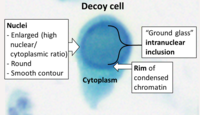
Photo from wikipedia
The index case is a 45‐year old male with unknown cause for native kidney disease, who received a kidney from his wife. Antithymocyte globulin (ATG) was used for induction, and… Click to show full abstract
The index case is a 45‐year old male with unknown cause for native kidney disease, who received a kidney from his wife. Antithymocyte globulin (ATG) was used for induction, and tacrolimus, mycophenolate mofetil and prednisolone were prescribed for maintenance. His baseline serum creatinine was 0.9 mg/dl. Two years after the transplant, the patient developed 3+ proteinuria on routine urinalysis with stable graft function. His 24‐hour urinary protein was 2.3 grams, serum albumin was 3.0 g/dl, and the total cholesterol was 251 mg/dl. The tacrolimus C0 levels were maintained between 6 and 8 ng/ml range. Allograft biopsy revealed diffuse thickening of glomerular basement membranes, with the immunofluorescence showing 2+ granular positivity along the loops for IgG and C3. Further, tissue staining for PLA2R and THD7A were both negative. Also, no donor‐specific antibodies (DSA) were detected, and serum PLA2R antibody assay was also negative. The patient was managed conservatively with losartan 50 mg and atorvastatin 20 mg, with subsequent reports of proteinuria of 1.5‐2.0 grams/day. After 52 months of renal transplant, the patient presented with a serum creatinine of 2.06 mg/dl and proteinuria of 6.8 grams/day. A repeat allograft biopsy revealed thickened glomerular basement membranes with spikes on silver staining. (Figure 1a) Further, immunofluorescence studies showed 2+‐3+ granular positivity for IgG, C3, with the added findings of C4d positivity on the peritubular capillaries and tissue PLA2R positivity on the basement membranes by immunohistochemistry. (Figures 1b‐d) The biopsy also revealed peritubular capillaritis and acute tubular injury. Antibodies to donor Class II (HLA DR) were positive with a mean fluorescence intensity (MFI) of 6885, but serum PLA2R antibodies remained negative. Based on these findings, the patient was treated with pulse methylprednisolone, 5 sessions of plasma exchange at 40 ml/kg with 5% human albumin and fresh frozen plasma replacement, intravenous immunoglobulin (at 100 mg/kg × 5) and rituximab (two doses of 1 g 2 weeks apart). Subsequently, the serum creatinine settled to 1.6 mg/dl, and DSA reduced to < 500 MFI. Three months after discharge, the serum creatinine is 1.5 mg/dl, 24‐hour urine protein is 982 mg/day and follow‐up DSA remains negative.
Journal Title: Transplant International
Year Published: 2021
Link to full text (if available)
Share on Social Media: Sign Up to like & get
recommendations!